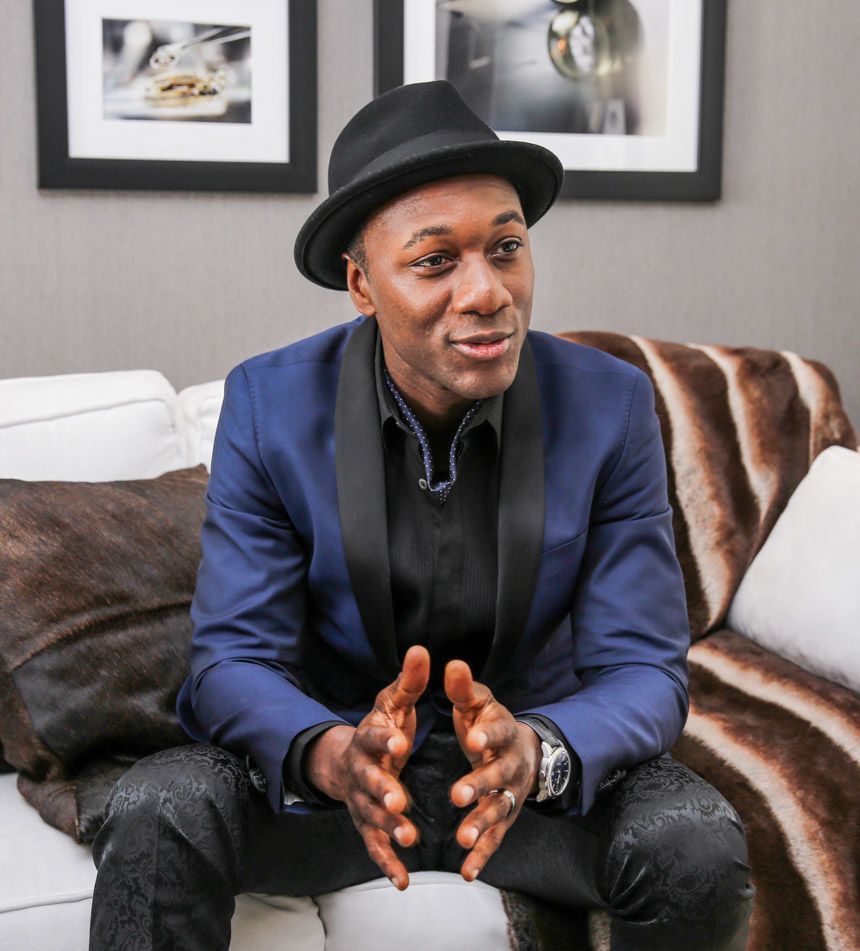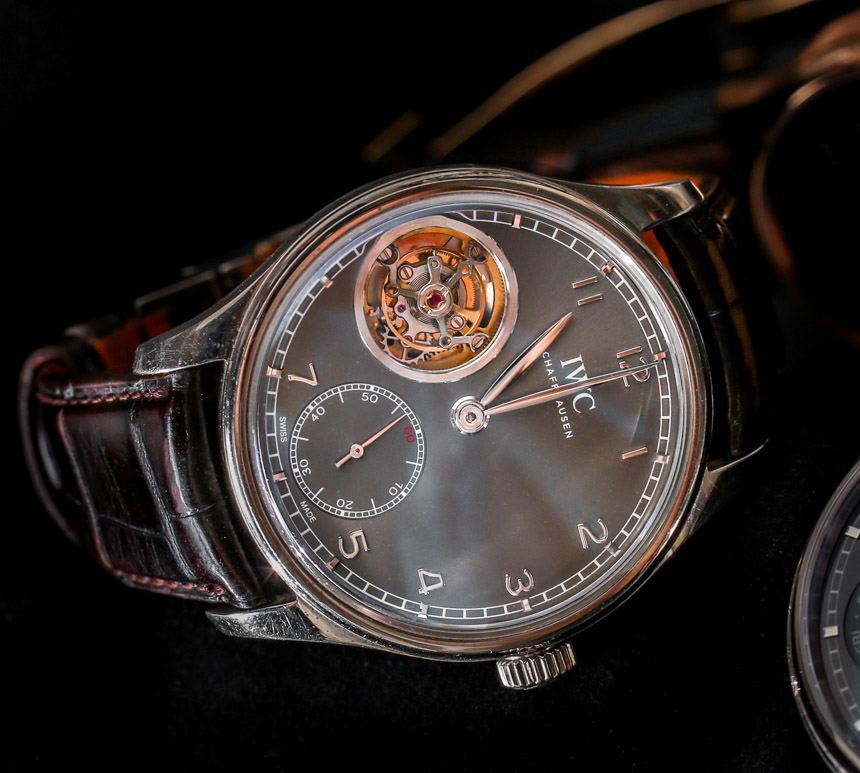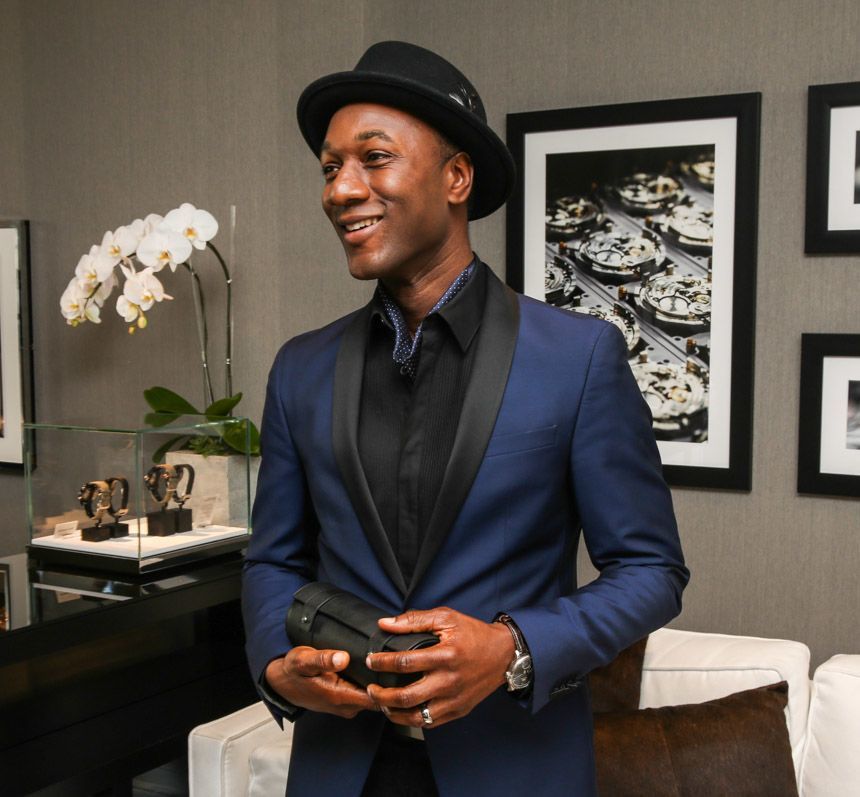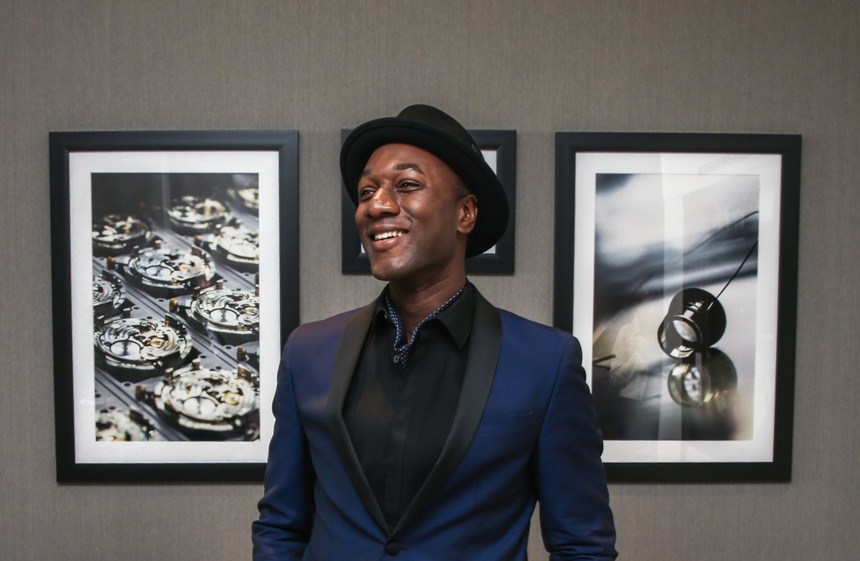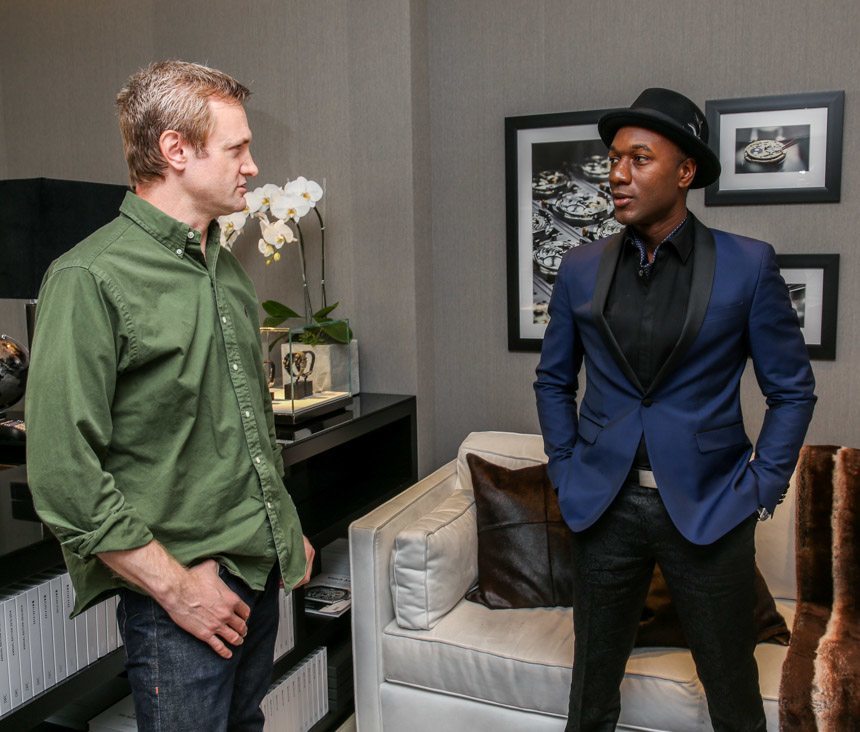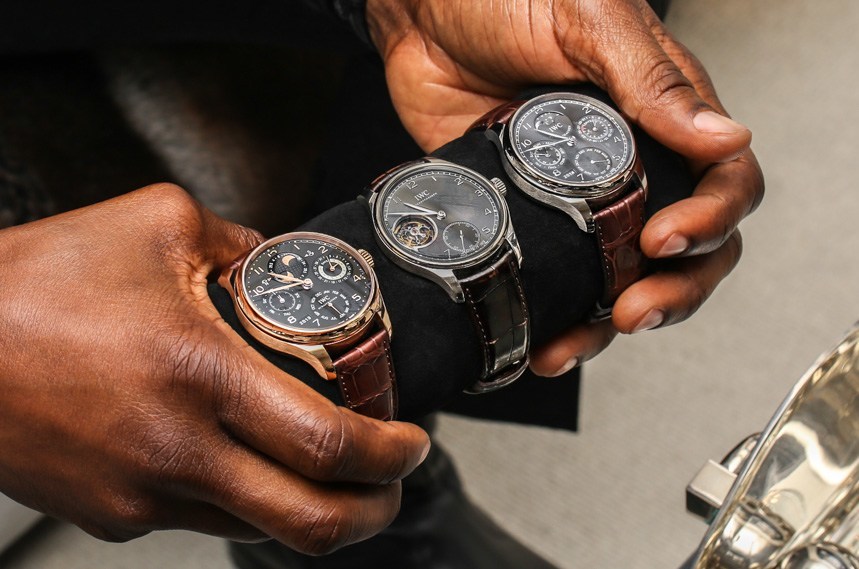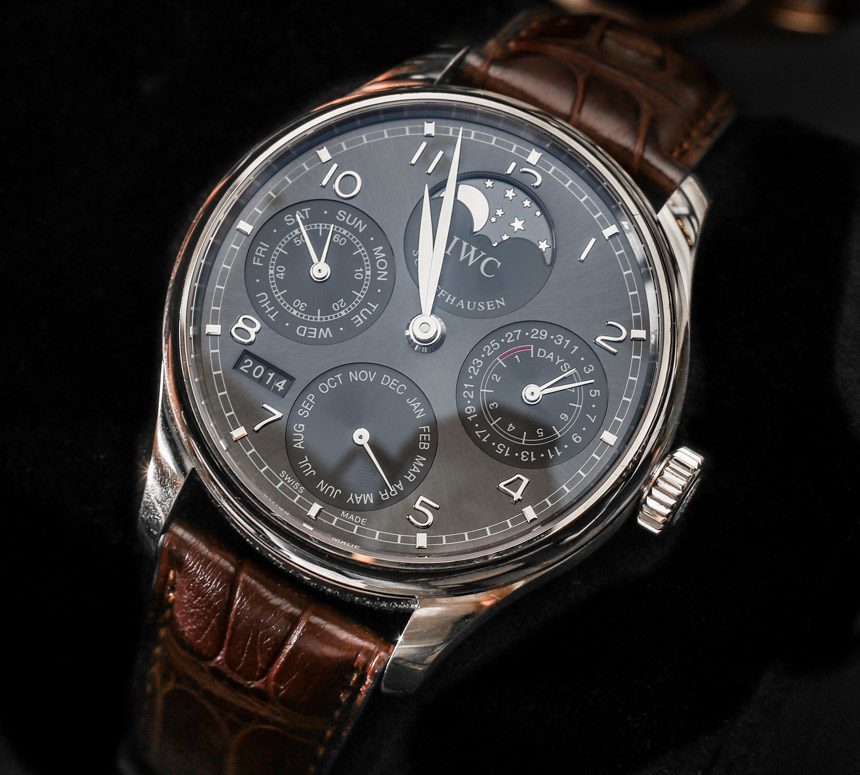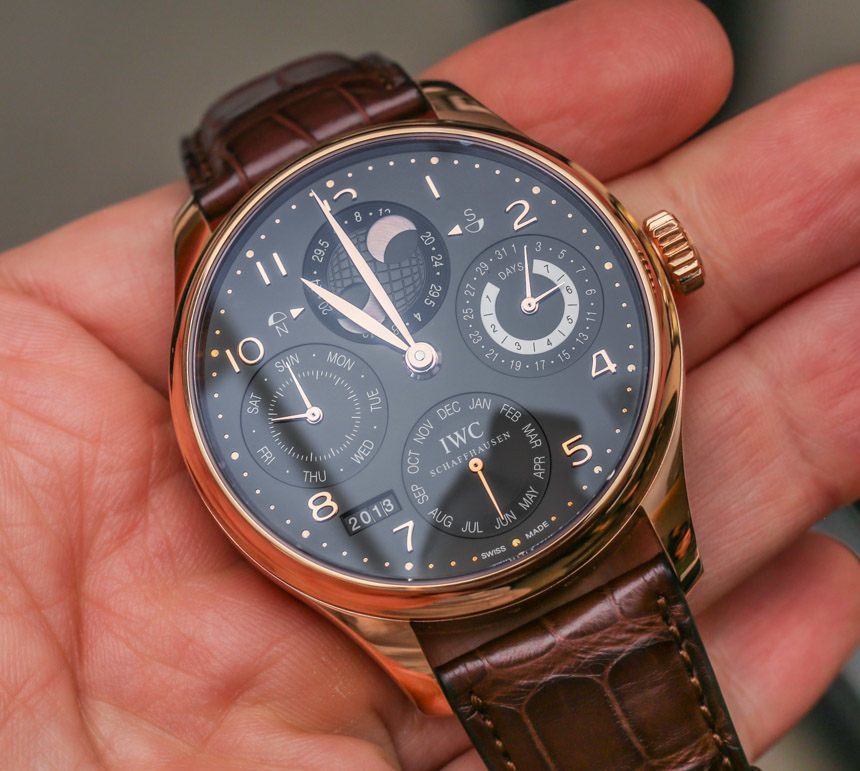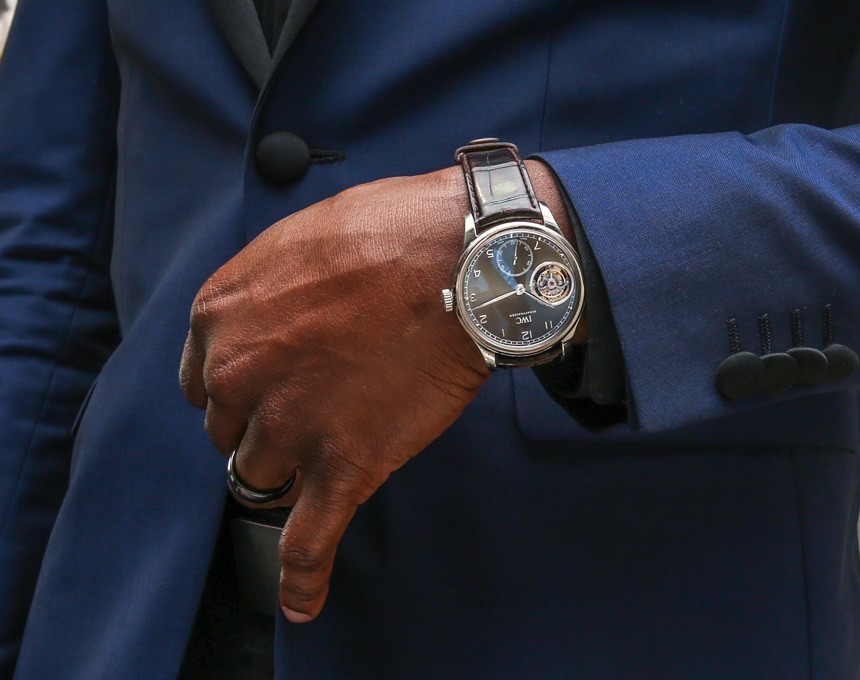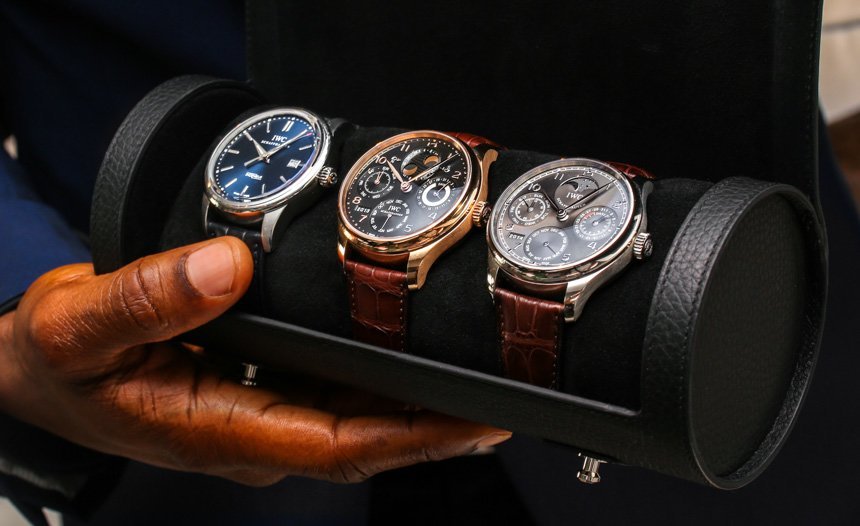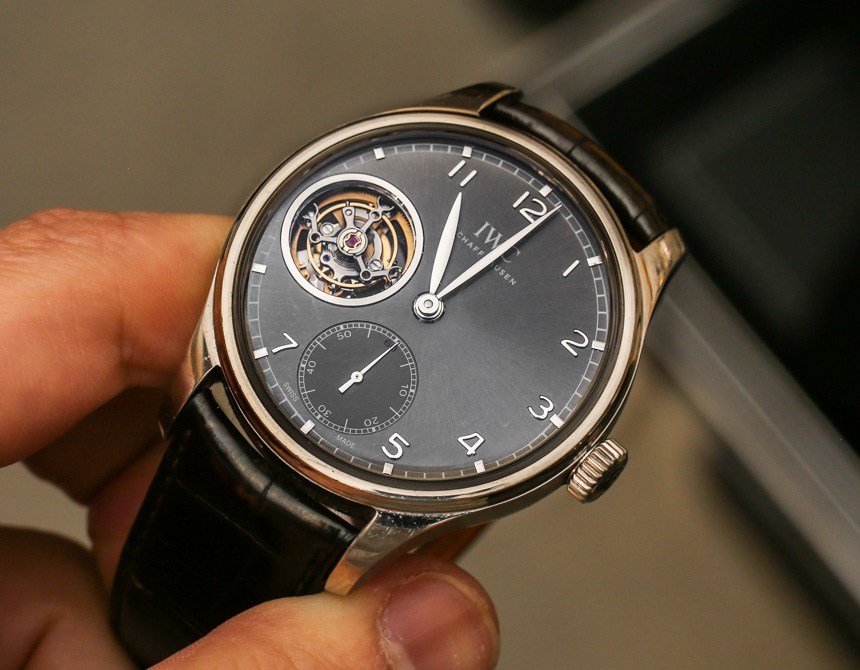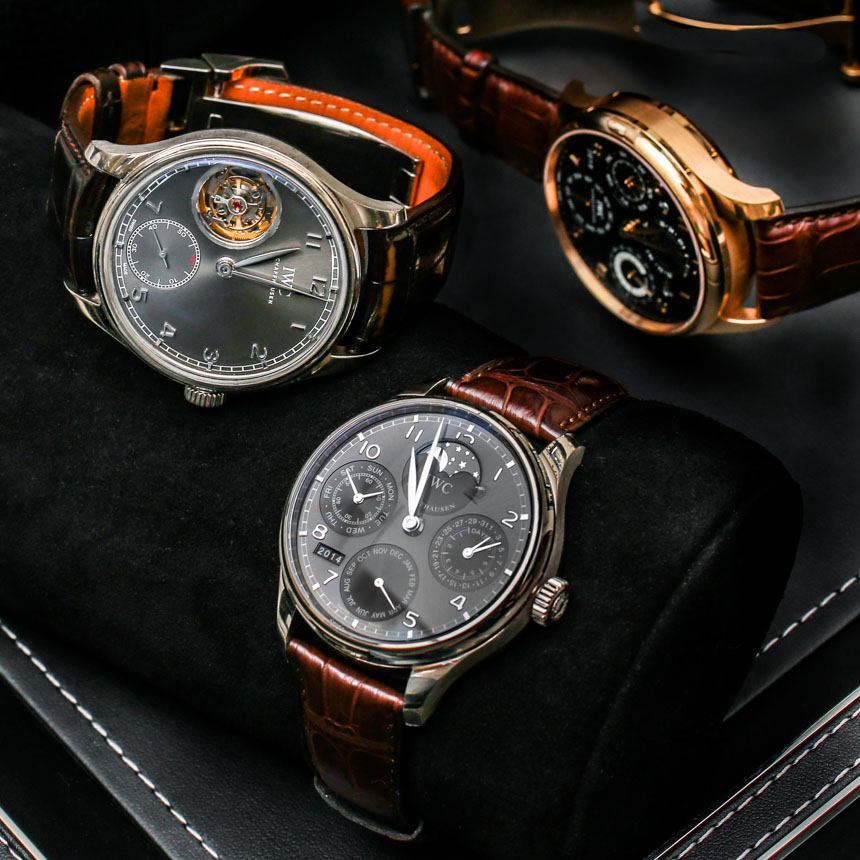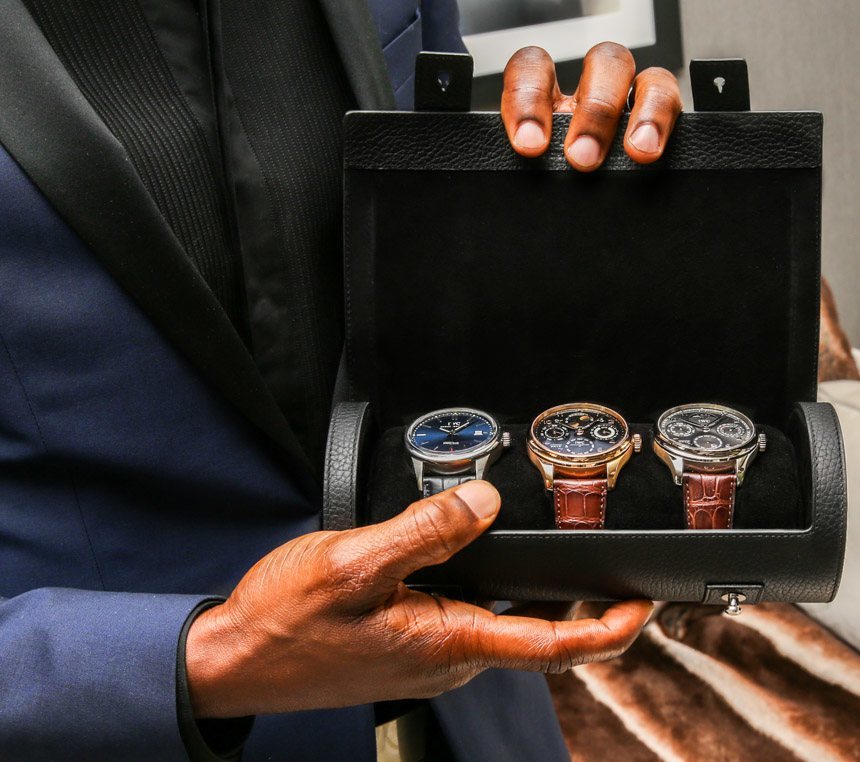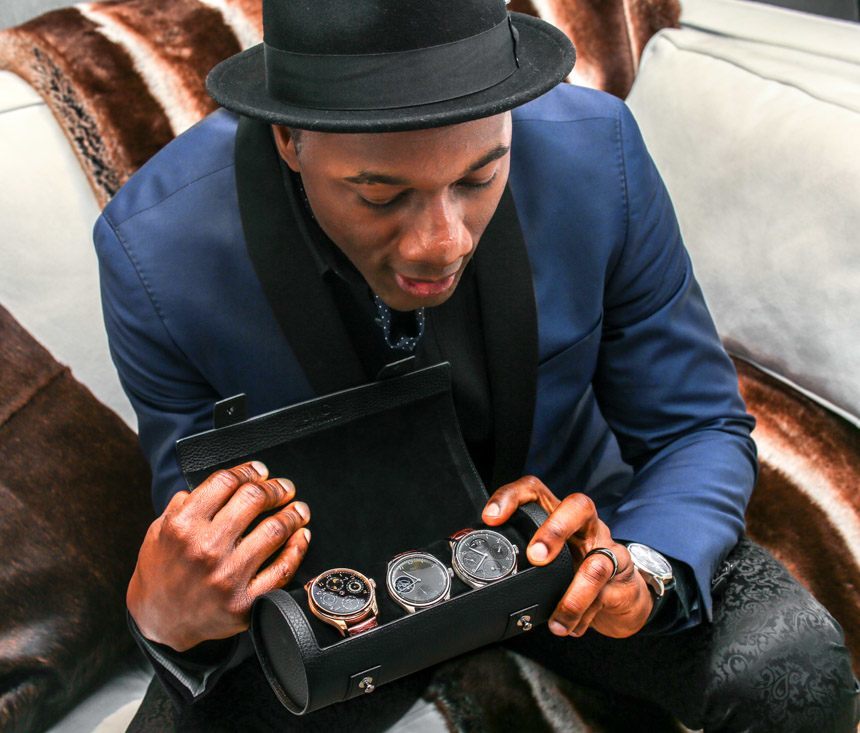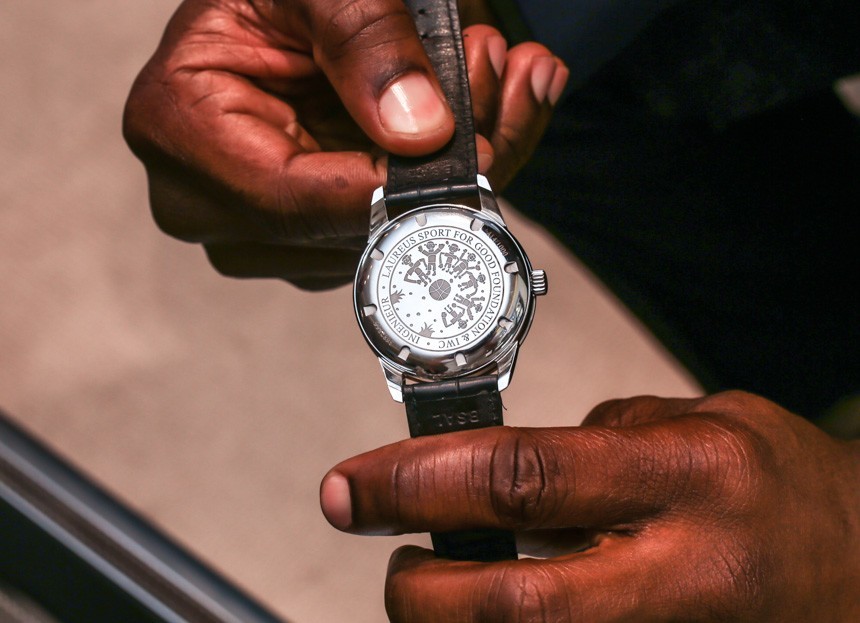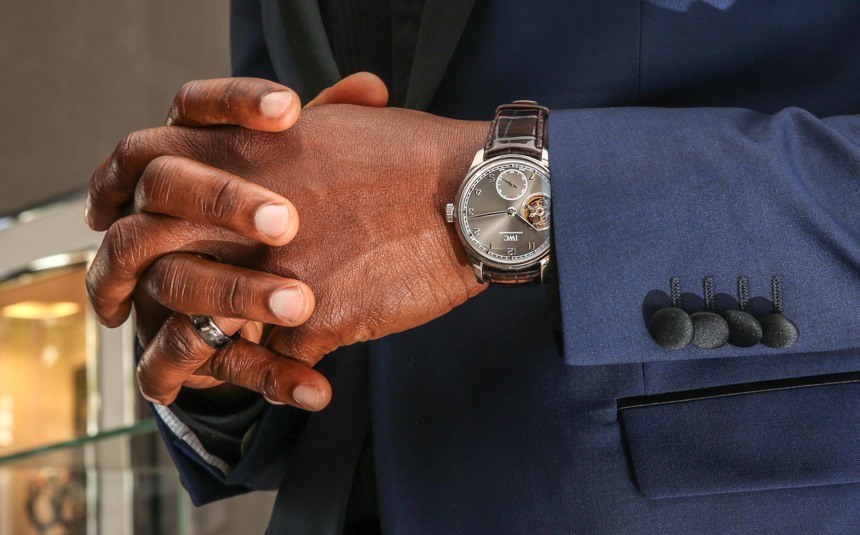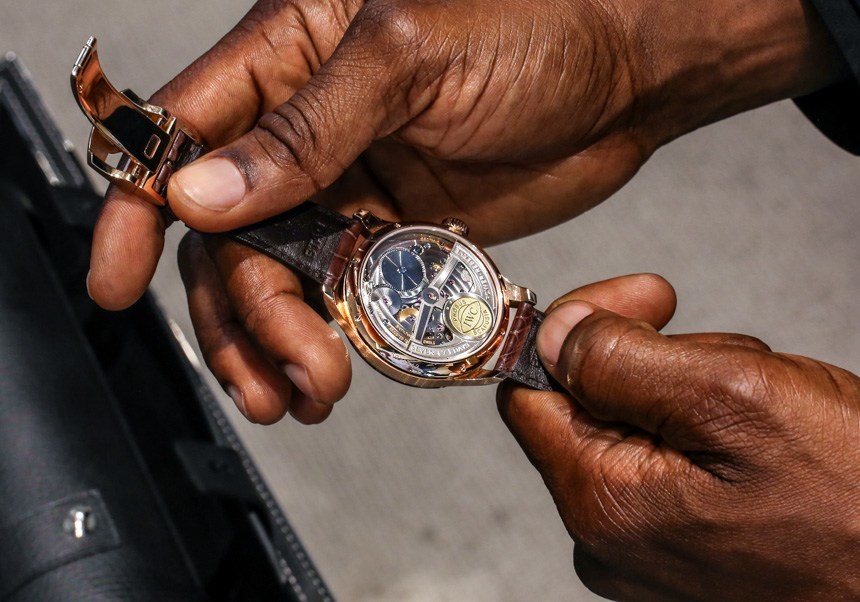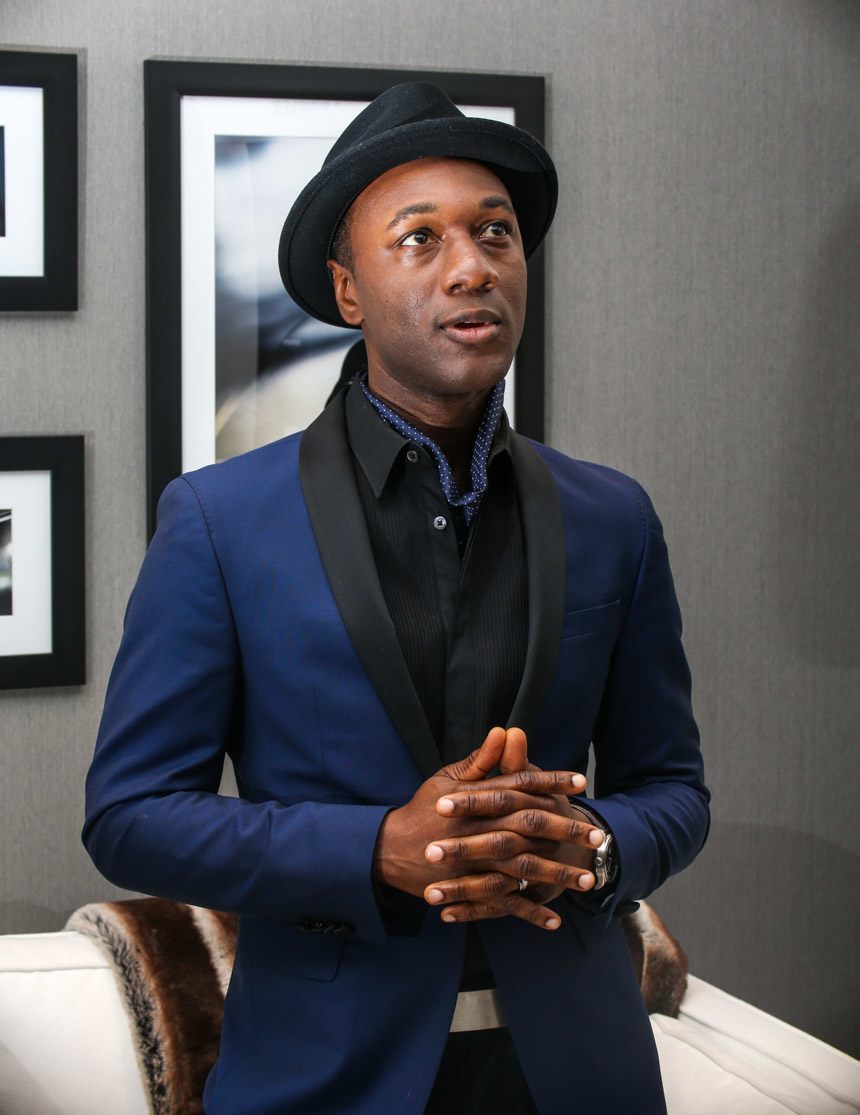 aBlogToWatch: How much are you into movements and the technical development of your watches?
aBlogToWatch: How much are you into movements and the technical development of your watches?
Aloe Blacc: It still baffles me. I don’t fully understand it, but I really love how this watch is always being wound by my movements. My favorite is the seven days of power reserve. If you wind it properly and wear it every day, your movement charges the watch, and you never have to worry about winding it again. I wish cell phones worked this way! [laughs] Why can’t we work out a power reserve for a cell phone?
aBlogToWatch: Would a watch’s mechanical movement ever inspire a song?
Aloe Blacc: I think it would. It’s a mesmerizing thing. At the IWC factory, I got to see the development and production of the Minute Repeater and how it works. I was amazed at how extremely intricate it is, and the amount of parts and work that goes into the piece. I was amazed at how infinitesimal the parts are, too – especially to think they’re all handmade, and require so much concentration to craft. But for me, the deepest insight comes from the watch itself – especially when you have an exhibition case back and can see the movement work.
aBlogToWatch: As a passionate watch person, something I’ve come to realize is that complications remind us of the poetry of time. We don’t always need a moon phase function, or a minute repeater, but they remind us there’s a beauty in time passing.
Aloe Blacc: Well, the second Perpetual Calendar I have is a dual moon phase: it allows me to see the moon phases in both the Northern and Southern Hemispheres. Why does anyone ever need that? Well, my wife is Australian, so quite often we’re in the southern hemisphere. [laughs] That’s a perfectly legitimate excuse to wear one. Georges was showing me IWC’s new dive watches recently. The wearer may never really go diving in these watches, but it’s about the concept and the care that’s taken – they’re an artistic statement from the culture around the lifestyle and utility they come out of.
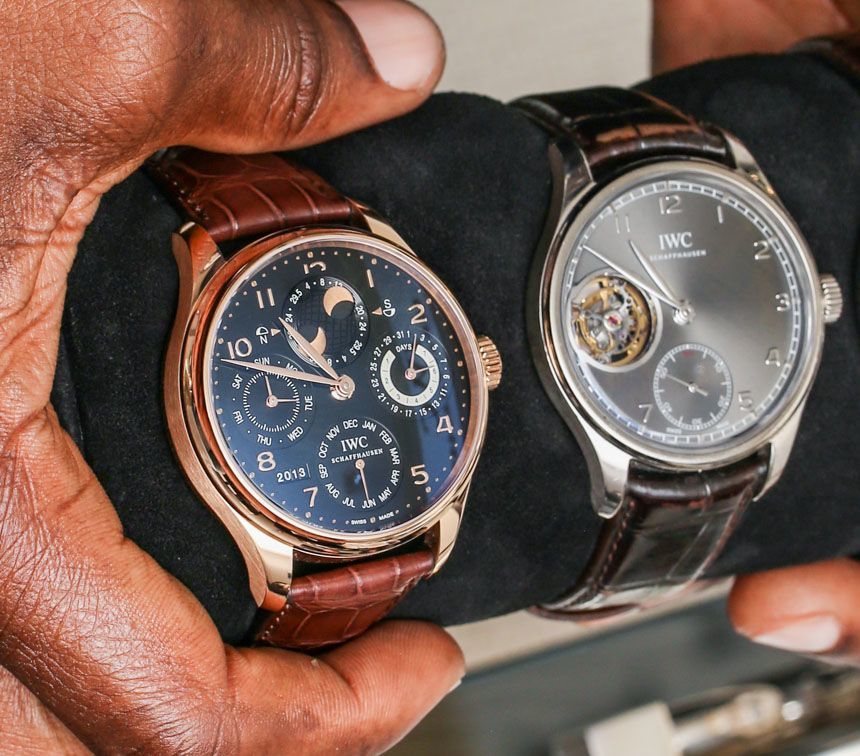
aBlogToWatch: Let’s say you had a young fan who, inspired by your example, desperately wanted an IWC timepiece but couldn’t afford it. Knowing what you know now, how would you advise this fan to start their watch collection?
Aloe Blacc: What comes to mind immediately is to canvas the antique shops and see if you can find a vintage IWC in your budget. Then you have a watch with a history and a story.
aBlogToWatch: Getting into vintage watches is a lot like ‘crate digging’! [‘Crate digging’ is a hip-hop musical term that describes the search for the most rare sounds and beats on vinyl to sample that no one else has.]
Aloe Blacc: I know, I know. I actually want to create a watch winder out of a turntable – maybe I’ll make one and auction it for charity! Basically, my background in everything is crate digging. I purchased an antique baby grand piano, and the serial number allows me to know where it was made and when, who owned it first, how it got all the way from New York City to California. It’s the same with an antique watch and the story it comes with.
aBlogToWatch: Many brand ambassadors for watch companies are getting involved in the process from conception to design for special editions [Kelly Rowland/TW Steel story]. Do you have a particular vision for the kind of watch you might collaborate with IWC to create?
Aloe Blacc: I’d like to work with IWC to create the most ecologically and socially peaceful fair-trade timepiece possible. From the people to the planet, I want everyone and everything involved with the watchmaking process to have been treated fairly, so that the resulting product is truly a luxury item. I just think it would be fantastic to work with Georges and IWC to find a way to make a watch that is completely conflict free – even down to the animals sourced to make the leather being treated as peacefully and safely as possible. For me, that would be the most expensive watch in the world: one that is a completely peaceful timepiece.
aBlogToWatch: It’s a beautiful notion.
Aloe Blacc: I think it can be done. I don’t think it’s impossible. I think people have come to expect, and demand, fair-trade products. You expect that everything that you purchase has been produced fairly; you don’t want to be surprised by ills that may come with those products.
aBlogToWatch: Indeed, right now, the consumer’s conception of luxury status goes beyond just precious materials. It’s also tied to the ethics involved, and the environmental impact. What IWC has done with the Galapagos Aquatimer models, for example, appears to be a decisive move towards a kind of socially responsible luxury.
Aloe Blacc: Absolutely. This is exactly what I’m saying! Beyond donating money from the sale of a watch to charity, the concept itself suggests to other makers of luxury items that, unless everybody and everything involved in the production of the product experienced luxury, perhaps it’s not as luxurious as it claims to be. I think it’s important to recognize that and celebrate that we can afford to create something that takes into consideration every being involved in the process. Going to IWC’s factory in Schaffhausen and seeing all the hands that make the watches, and how well everyone is treated, and how much care and pride they take in painstakingly creating the best product – this is what reminded me of this concept.
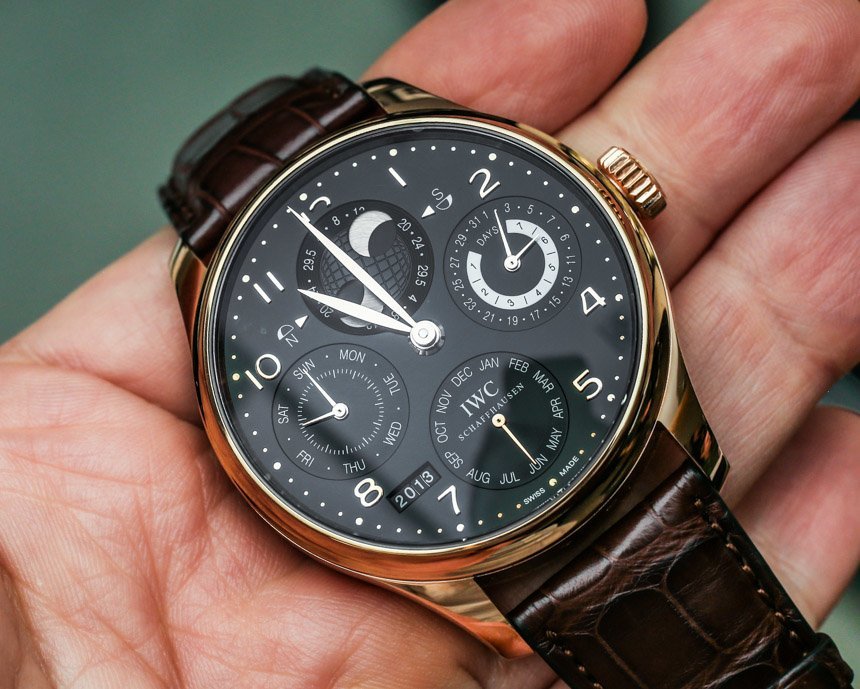
aBlogToWatch: There’s an interesting entrepreneur named Peter Thum who’s the CEO of a socially-responsible company called Fonderie 47. Fonderie 47’s flagship product is a $350,000 tourbillon watch made out of metal from guns reclaimed from places of conflict spanning Africa to inner-city America – there’s a little bit of an AK-47 in all their watches. When I interviewed Thum about the intent behind this revolutionary project, I asked him who he was trying to reach at that price point. His response was basically that the people who can afford a $350,000 watch are the people making the decisions that affect lives around the globe.
Aloe Blacc: This is an absolute truth: it starts there. If you can change the thinking of the people in that echelon who are able to afford these items – who own the companies that are, say, extracting minerals from the earth – maybe they might think more compassionately about their workers and how they produce their products. For me, my philanthropic interests are largely about representing people who don’t have the advantages and resources that I have. My challenge, and how I stay connected, comes from recognizing that there are real issues that require the help of world leaders and global voices. I consider myself a global voice at this point: I can write a song and present it to the world for everybody to hear. Once they’ve heard it, I have the opportunity to speak about issues – on televisions, in interviews, and even in the lyrics. For the video to my version of “Wake Me Up,” I decided to have one of the non-profit organizations I’m affiliated with use it as a commercial to draw attention to its cause. If they can use my celebrity and my song to promote the good work they’re doing, I’m happy to lend that time and space.
aBlogToWatch: When did your interest in watches begin?
Aloe Blacc: As a young kid. I went through all the popular watch crazes. When Swatch was popular, I wanted a multicolored Swatch; in middle school, I wanted a big fat G-Shock that could go deeper underwater than any human being could ever go! [laughs] My dad was a U.S. marine and had a few different watches, which I’d rotate around to wear to school. For a while, I wore my dad’s government-issue military pilot’s watch. I loved it: it had a canvas strap and green face with strong, bright lume on the hands. After that, TAG Heuer was very popular, so I got in on that. But it wasn’t until I started thinking about what I wanted to present as a singer and as an artist that I really considered what brand of watch I would wear. I’m not too into wearing too many different brands of anything – not just watches but clothing, shoes, cars. But if I know if the manufacturer is making it right, I trust them.
aBlogToWatch: Another thing that I love about your trajectory is that, before diving into your musical career, you’d graduated from the University of Southern California and quickly went into the corporate world. What watch did you wear in that professional environment – one so very different from where you’d end up in your current career?
Aloe Blacc: I went to work with Ernst & Young as a strategy consultant. I’d just left college, so I was still about the TAG. I never really got into Rolex. I thought about it, but at that point, I was so anti-commercial hip-hop, and Rolex was just too symbolic of that world. I decided I wouldn’t wear a Rolex as a protest against the blinging out that had taken over popular culture.
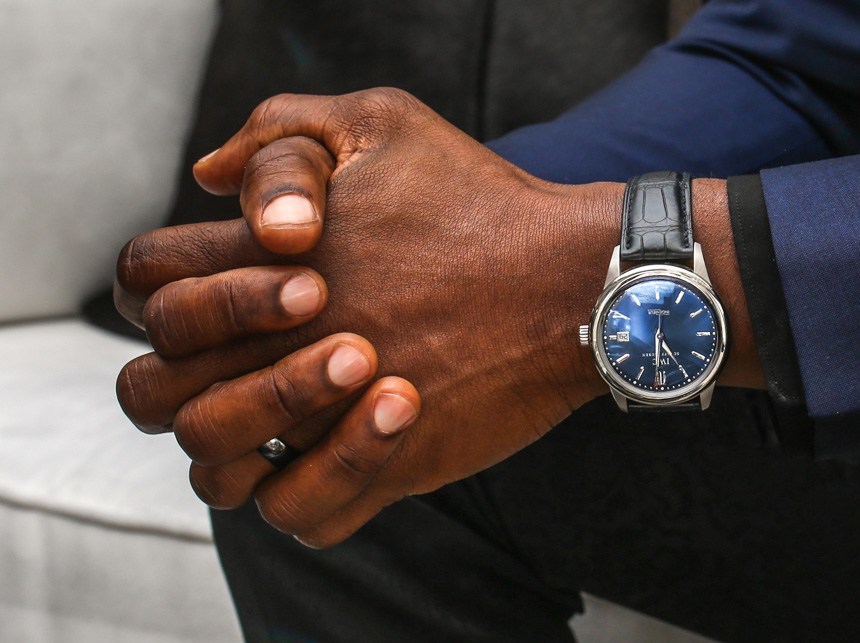
aBlogToWatch: Was there an epiphany that sealed the deal on your passion for watches?
Aloe Blacc: I had two of them. The first was during my senior year of high school, when I didn’t actually want to wear a watch. I thought wearing a watch was like wearing a handcuff where you were cuffed to the restrictions of time: I was so busy and in charge of so many things, and I just got frustrated that there wasn’t enough time to do everything. I started to ideate at the lateral access of time, rather than the linear and direct. I don’t know if you’re familiar with Zeno’s Paradox… The concept of it is something like, if were to walk halfway across the room, and then walked the rest of the half from that point, and then went halfway again, you’re halfway to infinity. And I wanted to access infinity.
My second watch epiphany was… That I’ll never be able to access infinity! [laughs] But what I can access, through music, is timelessness. As such, I need to present myself in a way that, when people see me, they recognize that timeless quality. So finding a watch and a brand that represents who I am makes all the difference.
aBlogToWatch: For me, my definition of luxury stems from innovation. I find it luxurious to wear something as ingenious and near perfect as, say, an Omega Speedmaster, or an IWC Tourbillon. Wearing innovative watches like that reminds me to aspire to a certain level of quality and innovation in my own life.
Aloe Blacc: All the time. A lot of innovation goes into these watches, and IWC has a beautiful history as well. Going to the SIHH events every year in Geneva, going to IWC Headquarters in Schaffhausen, I’m able to see that and be inspired. I really enjoyed looking at all the watches IWC made throughout the years. It’s really interesting to see the development over time. I’m a process nerd: I’m into how things are done. Even in making music; for me, I’m more interested in the process of creating it than the final product – and then I’m ready to move on to another process.
aBlogToWatch: One thing I’ve always appreciated about your music is it’s contemporary, but also acknowledges history in an artistic way. And making a parallel with watches, especially a brand like IWC, the work reflects a deep heritage, but more than anything, it’s about the “now.”
Aloe Blacc: That’s it. I always felt like there was a way to integrate my understanding of and appreciation for the forefathers and foremothers in music – the heroes I look up to in songwriting, production, and musicianship – and use all of that experience and knowledge to create something new that will work for a contemporary audience. But it’s a delicate balancing act. On my last album, Good Things, I played heavily on the side of antiquity, paying homage to classic soul and funk. And on my new album, Lift Your Spirit, songs like “The Man” pay respect to singer-songwriters like Elton John, but also use production techniques to create something palatable to a contemporary audience. “The Man” has so many different elements: a classic Russian folk melody, the Elton John lyric and melody in the chorus, a drum pattern similar to a song Nas did on Illmatic, “New York State of Mind.” There’s even a homage to classic Ethiopian music in the bridge, where the trumpet plays a 6/8 melody on top of a 4/4 time signature. That’s what makes the song sound rich and new every time you hear it. With as many songs as possible, I bury enough mystery in them so there’s always something to discover. And that’s what’s beautiful about being able to wear an IWC watch. Every season there’s something new. Nothing is ever duplicated, and each watch is basically handmade, so it has its own essence.

aBlogToWatch: I wondered how your interest in high-end timepieces connected to the socially-progressive messages in songs like “I Need a Dollar” – messages that, indeed, inform the majority of your music – as well as the anti-bling attitude of the progressive hip-hop/R&B scene you came out. After thinking about it for a while, I realized that, when you’re wearing an IWC watch, it’s not a statement of flash or wealth, like it might be with another brand, as much as it is a reflection of taste. It’s an appreciation, a celebration, of how far you’ve come. More than anything, it makes an aspirational statement.
Aloe Blacc: Absolutely. I think my niche in music is about motivation, inspiration, and aspiration. I’m fortunate enough at this point to have a comfortable lifestyle and make a living for my family, and I want to be able to inspire others – with my music, in how I dress, and what’s on my wrist. There are so many examples in the media of struggle, destitution, negativity; I just want to be an inspiration for better.
aBlogToWatch: Steve McQueen had his famous Heuer chronograph; Paul Newman had his namesake Rolex Daytona. Those watches came to be seen as symbols that represented their integrity as individuals – as men.
Aloe Blacc: In a lot of ways, my watch represents who I am, but it doesn’t say anything about where I’m from. When people see the watch on my wrist, they don’t see the humble, middle-class upbringing I had as a Panamanian kid growing up in Orange County. They don’t get any of that history; they don’t feel the struggles that my parents went through, and that their parents went through. That’s okay – I put that in the music. But when they see the watch, they see aspiration. They see not where I’ve been, but where I’m going.

